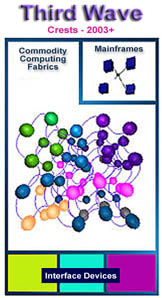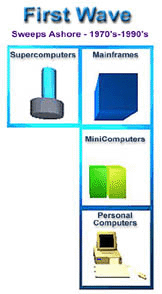 |
FIRST
WAVE Appears (1940's)
The
first electronic computers were supercomputers, used for defense
and scientific research. (Cray icon used for symbolic purposes only
- the Cray debuted in the 1970's)
FIRST
WAVE Rises (1950's)
Supercomputers gave rise to machines for business and financial
use, called mainframes.
FIRST
WAVE Swells (1960's-1970s)
Minicomputers make the scene. They fit the needs and budgets of
departments and smaller organizations that can't afford or justify
the expense and overhead of a mainframe.
FIRST
WAVE Sweeps Ashore (1970's-1990s)
The
microprocessor spawns the personal computer.
Advanced microprocessors, coupled with large memory, megapixel graphic
displays, advanced OSes, Ethernet, and distributed file systems
become technical workstations that were to supercomputers what PCs
were to mainframes.
|
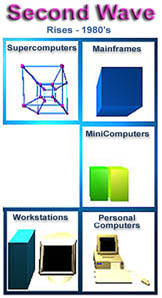 |
SECOND
WAVE Rises (1980’s)
Supercomputing introduces robust parallel and distributed processing. |
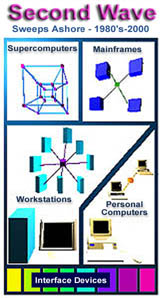 |
SECOND
WAVE Sweeps Ashore (1980's-2000)
Minicomputers adopt clustering, multiprocessing, and fault tolerant
storage to challenge mainframes, which hold their position due to
the enormous investment in customer mainframe software.
Mainframes
adopt multiprocessing and clustering.
Workstations
adopt multiprocessing and clustering to successfully challenge low-end
supercomputers.
PC
servers adopt multiprocessing, clustering, and fault tolerant storage,
and with workstation-based servers, challenge and displace the minicomputer.
Laptops,
handhelds, smart cards, information appliances, game consoles, TVs,
set tops, and communicators create a new computing layer close to
the user and become a market segment, the new entry-level. Entry-level
PCs merge with this category from above as pagers and cell phones
merge from below.
Workstations
and advanced PCs converge. PCs adopt multiprocessing, Gigabit networking,
clustering, 3D acceleration, and, with the IA-64 Merced processor,
large memory, big caches, and RISC techniques, making them full
fledged technical workstations; Workstations adopt commodity microprocessors
(IA-64), making them cost competitive with PC workstations, while
featuring faster 3D graphics through custom ASICs.
|
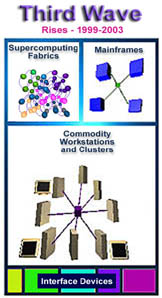 |
THIRD
WAVE Rises (1999 - 2003)
Supercomputers
and superservers become the first Computing Fabrics ss the interconnects
and architectures within supercomputers converge with the networks
between them, supported by fully functional distributed operating
systems.
Supercomputer
vendors adopt commodity microprocessors, leaving their R&D resources
available for faster development of modularly scalable interconnects,
distributed architectures, and distributed operating systems which
"trickle down" to low-end and mid-range markets for the
first time.
Entry-level
devices converge with new wearable and embedded systems, poised
to become powerful interface devices to Computing Fabrics.
|
|
|
THIRD
WAVE Crests (2003+)
The
trickle-down becomes a downpour, providing the industry with modular
bus replacements, single system image clusters, and ultra capacity
networks, now coupled with automated transparent object distribution.
Massive
leveraging of technology eradicates the market boundaries erected
by the first wave and eroded by the second as a scalable architecture
is embraced all the way from desktops to supercomputers.
R&D,
design, and production investments in enabling technologies become
applicable across this entire spectrum, moving both up and down,
creating an industry-wide economy of scale never seen before.
THIRD
WAVE Sweeps ashore (2005+)
Mainframes and their software adopt Computing Fabric technologies.
New
technologies easily integrate into the fabric and support fluid
system boundaries at the processor scale, including nanoscale flexible
logic arrays, optical computing, and bioelectronics. These begin
to displace microprocessors just as microprocessors fall off Moore’s
Law.
|
| The
fabric paradigm ultimately scales across all levels, from global broadband
connectivity, through systems architecture, even reaching within the
processor itself. Computing Fabrics will stand as the microprocessor’s
grandest achievement, as well as the beginning of its own demise.
|
Updated October 5, 1998
|










